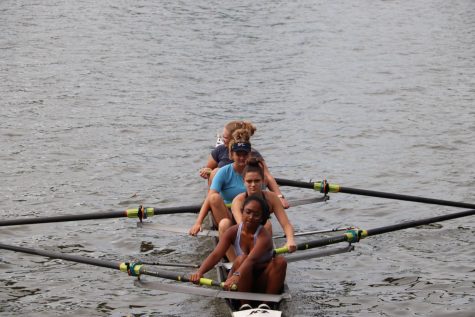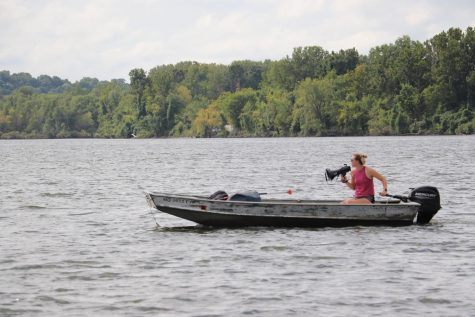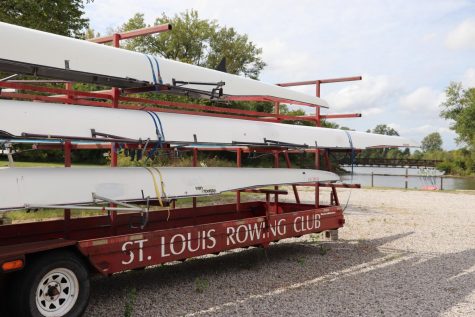“Sailboat Cove” is written in large letters on the sign. The boathouse is big, tan and tucked behind a 320-acre lake. In front of it are rows of long, white boats, some accented with red or blue stripes. Steps away are docks floating on the glistening turquoise water. Nearby, people are picnicking on the pebble beach, rollerblading on the trail, kayaking and fishing. No, this is not a different city. This is Creve Coeur Lake. Fourteen miles from KHS. And home “field” for seven KHS students.
These students are part of St. Louis Rowing Club (SLRC). Eilish Frissell, senior, was inspired to try rowing after seeing athletes from the University of Kansas’ rowing team on a college tour. She joined the team last fall after hearing about SLRC’s tryouts for inexperienced 13-16-year-olds that take place in the fall and spring.
There are no star players. [Rowing] rewards hard work. It’s not luck, just the whole team working together.
— Ethan Peterson
“At first I didn’t think it would be hard at all,” Frissell said. “I thought it would be an easy late start [sport] but it is so physically demanding. It’s harder than soccer for me.”
Frissell said her height makes rowing more difficult. She is 5-foot-3, but said most rowers are 5-foot-7 or taller. She said it makes the sport twice as hard. Frissell’s teammate, Macy Christensen, junior, has broad shoulders and is 5-foot-9. She said the way she is built helps, but doesn’t take away the challenge.
“You have to be mentally stronger than any sport I’ve done before,” Christensen said. “It gets difficult to the point where I want to give up so many times. You have to build the mindset of ‘I just gotta keep going.’”
Since SLRC is the only rowing team nearby, the team travels across the country to compete in regattas (rowing competitions). Their first regatta this season was on Oct. 2 in Nashville. Frissell described regattas as “an all day affair,” lasting from early morning until late afternoon, but said races are only about seven minutes long. Dean Hooks, SLRC varsity girls’ assistant coach, pointed out how few people outside the rowing community have been to regattas.

“A lot of people are doing [rowing] for self satisfaction or for the team, as opposed to the glory,” Hooks said. “I bet most people couldn’t name a single Olympic rower, but they could name a lot of ice skaters and track and field athletes. People do it because they love the sport and enjoy challenging themselves.”
As a former runner himself, Hooks said it is common for people to start rowing later in life and come from other sports. He started rowing when he was 50 years old and has done it for 11 years.
“When’s the last time you’ve seen a bunch of 40, 50, 60 year olds who work as hard as they physically can, run as fast as they can, lifted as much as they can or done the most chin ups?” Hooks said. “For people our age that doesn’t happen much anymore.”
Hooks said SLRC has members in their 70s and 80s. He believes that along with the challenge, rowers enjoy the social aspect of the sport. Ethan Peterson, senior, loves the bonds he has made with his teammates.
“In the boat everyone’s doing the exact same thing,” Peterson said. “There are no star players. [Rowing] rewards hard work. It’s not luck, just the whole team working together.”

Each boat has eight rowers and a coxswain who steers the boat. The spots are chosen by coaches based on skill level and dedication. Hooks said that technicality is another important part of the sport.
“Rowing can be difficult to do right,” Hooks said. “You have to learn to do things precisely while you’re tired. Your body is telling you to stop and everything hurts, but you still have to do the right technical thing.”
Peterson and Christensen believe the challenges of the sport get overlooked. Peterson said some of his friends think rowing is like kayaking, not realizing that it is a full body workout.
“People say that rowing isn’t a sport, [but] that can’t be farther from the truth,” Christensen said. “A lot of people don’t know that the seats move and [that] you’re actually pushing off with your legs. A lot of people think it’s just with your arms, [but] you barely pull anything with your arms.”
When you think you don’t have anything left, you do. You can always find it in you to go a little harder.
— Jane Upmeyer
Another misconception Peterson mentioned is that rowing is “preppy” or for the “upper class,” which he said could be due to bad press. According to CNN, Lori Loughlin and Mossimo Giannulli used a staged picture to get their daughter, Olivia Jade, accepted as a crew recruit at USC during their infamous college admissions scandal. Peterson disagrees with this stereotype. He said all his teammates are hard-working which pushes him to do better.
“We go through pain side-by-side,” Peterson said. “We’re in the same boat doing the same race. When we train in the winter, [we’re] using the rowing machine right next to each other. We’re all going through the exact same thing and it’s motivating to be around people who are working hard.”
Frissell, Peterson and Christensen said they like how rowing gets them outside of the Kirkwood community. Jane Upmeyer, senior, is thankful for the relationships she’s made with athletes from all over the St. Louis area.

“A bunch of my friends on the team are artists, a couple are in Girl Scouts and a couple played soccer before they came,” Upmeyer said. “Everyone has a different story, and you learn that through the sport.”
Next year, Upmeyer will row for Clemson University. She said a positive of rowing is colleges’ willingness to give scholarships to female athletes. This is because of Title IX of the Education Amendments of 1972, which gave women athletes equal opportunity in sports that receive federal funds. Since starting the sport last fall, Upmeyer said it’s changed her life and has taught her life lessons like never giving up.
“When you think you don’t have anything left, you do,” Upmeyer said. “You can always find it in you to go a little harder.”
This story was originally published on The Kirkwood Call on October 21, 2021.





























![IN THE SPOTLIGHT: Junior Zalie Mann performs “I Love to Cry at Weddings,” an ensemble piece from the fall musical Sweet Charity, to prospective students during the Fine Arts Showcase on Wednesday, Nov. 8. The showcase is a compilation of performances and demonstrations from each fine arts strand offered at McCallum. This show is put on so that prospective students can see if they are interested in joining an academy or major.
Sweet Charity originally ran the weekends of Sept. 28 and Oct. 8, but made a comeback for the Fine Arts Showcase.
“[Being at the front in the spotlight] is my favorite part of the whole dance, so I was super happy to be on stage performing and smiling at the audience,” Mann said.
Mann performed in both the musical theatre performance and dance excerpt “Ethereal,” a contemporary piece choreographed by the new dance director Terrance Carson, in the showcase. With also being a dance ambassador, Mann got to talk about what MAC dance is, her experience and answer any questions the aspiring arts majors and their parents may have.
Caption by Maya Tackett.](https://bestofsno.com/wp-content/uploads/2024/02/53321803427_47cd17fe70_o-1-1200x800.jpg)
![SPREADING THE JOY: Sophomore Chim Becker poses with sophomores Cozbi Sims and Lou Davidson while manning a table at the Hispanic Heritage treat day during lunch of Sept 28. Becker is a part of the students of color alliance, who put together the activity to raise money for their club.
“It [the stand] was really fun because McCallum has a lot of latino kids,” Becker said. “And I think it was nice that I could share the stuff that I usually just have at home with people who have never tried it before.”
Becker recognizes the importance of celebrating Hispanic heritage at Mac.
“I think its important to celebrate,” Becker said. “Because our culture is awesome and super cool, and everybody should be able to learn about other cultures of the world.”
Caption by JoJo Barnard.](https://bestofsno.com/wp-content/uploads/2024/01/53221601352_4127a81c41_o-1200x675.jpg)






